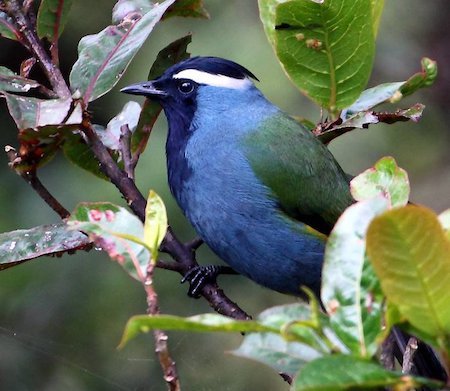Paramythiidae – Painted Berrypeckers

The painted berrypeckers, Paramythiidae, are a very small bird family restricted to the mountain forests of New Guinea. The family comprises two species in two genera. These are colourful medium-sized birds, which feed on fruit and some insects. These species were formerly included in the Dicaeidae, but DNA-DNA hybridization studies showed these species were related to each other but distinct from the flowerpeckers. Some sources group painted berrypeckers as two genera belonging to the berrypecker family Melanocharitidae.
The painted berrypeckers are small to medium sized passerine birds. The smaller species ranges from 12–14 cm in length and weighs around 17–21 g. The larger Crested Berrypecker is 19–22 cm in length and latter is due to differences in altitude with birds being larger at higher altitudes. Both species have short necks, moderately long and broad rounded wings, and plump bodies. The tails vary between the two species, with the Tit Berrypecker having a short square one and that of the Crested Berrypecker being longish. In both species the short bill is strong and black.
The plumage of both species is soft, downy and brightly coloured. In both species the backs and wings are green and the tail is blue-grey. In the Tit Berrypecker the plumage is sexually dimorphic, with the male having bright yellow patches on the face, wing and chest but the female being overall duller. Both sexes of the Crested Berrypecker are similar, but the species exhibits instead some variation between two subspecies. Both species have unique filoplumes (hairlike feathers) on the flanks that are not visible in the field and the function of which is unknown.
Both species of painted berrypecker are endemic to the islands of New Guinea, one of two families to be restricted to the island (the other being the berrypeckers and longbills). Both species are restricted to montane areas, usually above 2200 m, though the tit berrypecker does occur as far down as 850 on occasions, and that species has a generally lower distribution than the crested berrypecker. Both species are arboreal birds of montane forest, particularly mossy forest. At higher altitudes the crested berrypecker will also inhabit stunted alpine forest and alpine thickets. It is unknown if the two species make any migratory movements, although it has been suggested that the tit berrypecker may be partly nomadic.
As far as is known, the painted berrypeckers are almost entirely frugivorous. Small fruits and berries comprise the biggest part of the diet, although the tit berrypecker has also been recorded eating small flowers. The crested berrypecker has also been observed to occasionally eat insects, and insects as well as fruit comprise the diet of nestlings.
There are just two species in this family of Painted Berrypeckers recently split from the other Berrypeckers; which are:
Tit Berrypecker Oreocharis arfaki
Crested Berrypecker Paramythia montium
-
Crested Berrypecker Paramythia montium
Species AccountThe crested berrypecker (Paramythia montium) is a species of bird in the family Paramythiidae. It is found in New Guinea. Its natural habitat is subtropical or tropical moist montane forests. -
Crested Berrypecker Paramythia montium
Species AccountSound archive and distribution map -
Crested Berrypecker Paramythia montium
Species AccountThe crested berrypecker (Paramythia montium) is a species of bird in the family Paramythiidae. It is found in New Guinea. Its natural habitat is subtropical or tropical moist montane forests. -
Tit Berrypecker Oreocharis arfaki
Species AccountSound archive and distribution map -
Tit Berrypecker Oreocharis arfaki
Species AccountThe tit berrypecker (Oreocharis arfaki) is a species of bird in the Paramythiidae family. It is monotypic within the genus Oreocharis.[citation needed] It is found in West Papua, Indonesia and Papua New Guinea. Its natural habitat is subtropical or tropical moist montane forests.
-
Number of bird species: 2
